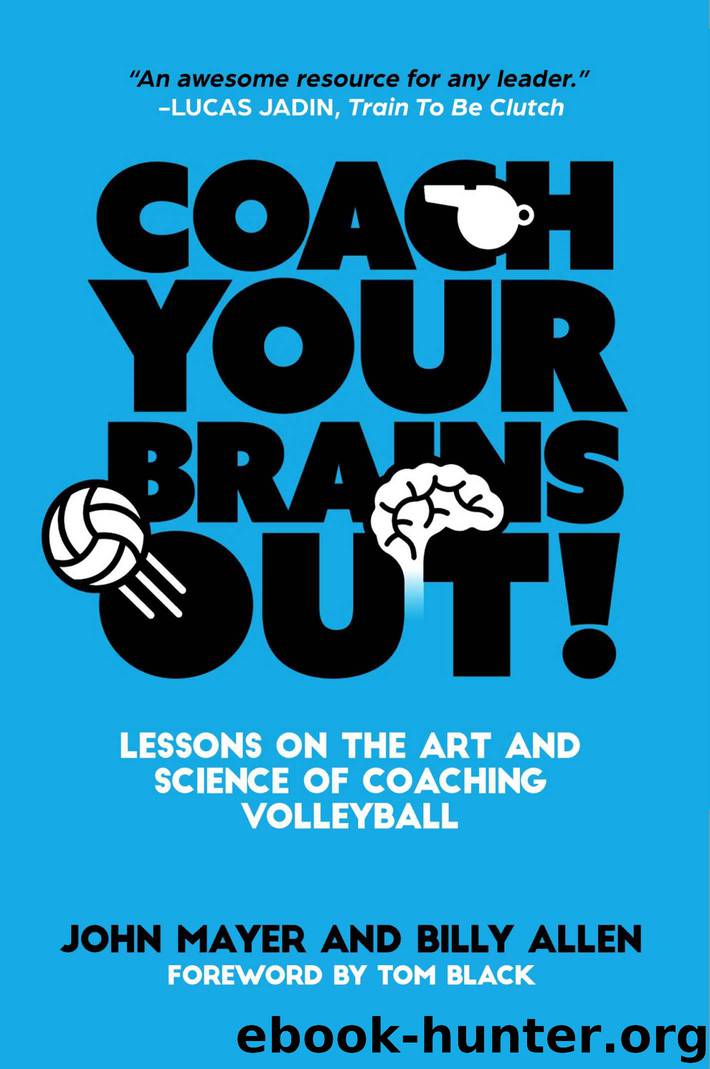Coach Your Brains Out: Lessons On The Art And Science Of Coaching Volleyball by John Mayer & Billy Allen

Author:John Mayer & Billy Allen [Mayer, John]
Language: eng
Format: azw3
Publisher: Moonglass Books
Published: 2019-06-17T16:00:00+00:00
Deliberate Practice Formula
The deliberate practice formula is a never ending cycle. After we reflect and refine we set a new stretch goal and start again. The more our players have a clear goal at which to focus their attention, the more deliberate the practice and the quicker they’ll improve.
With the deliberate practice formula in mind, let’s begin by setting a stretch goal.
Example: Deliberate Passing
Depending on your level, a stretch goal is likely something more specific than “I want to improve my passing.” For example, the athlete and coach could study film and notice that the athlete is often going to a knee in serve receive. The statistics show that passers are more accurate when they’re on two feet (it also helps if you’re going to attack). Therefore, a helpful stretch goal for the athlete today will be to shuffle when passing.
When deciding on the focus to help accomplish the stretch goal, it’s a great time to use Dr. Wulf’s research on autonomy by giving the athlete “two good options.” You could ask the athlete, “do you want to focus on shuffling when you move or reading the line of the serve?” Both skills will help your goal of improving her ability to stay on two feet when passing, while also giving the athlete autonomy over their learning process.
For our example, let’s say the athlete chooses to focus on shuffling when she moves in serve receive. If on the first rep the passer shuffles smoothly, but their platform is bent and complex, what should you do?
A coach with deliberate practice in mind will catch them doing it right and give feedback on the shuffle and not distract them with feedback on their platform. This is hard to do and is a skill that will take time for you to develop. (Practice deliberately!)
Another big trap for athletes and coaches aiming to engage in deliberate practice is the distraction of the result. Let’s say our athlete, who is focused on improving her shuffle in serve receive, has another great shuffle to the serve but overpasses the ball. This can divert her attention and take her off her specific stretch goal. It can also lead to frustration. (“See, it’s not working!”)
An athlete’s results will often suffer for a short period of time when attempting to change a movement pattern. However, if we know that this movement pattern is a superior fundamental, then we will sacrifice a short-term result for a long-term gain.
There are many elements that go into consistent passing, and if you, as a coach, have the long game in mind you’ll focus on one specific stretch goal at a time. Not because we are okay with poor outcomes, but because we believe in long-term learning.
Let’s recap with the deliberate practice formula in mind. The athlete has identified their stretch goal and can perform the skill between 4-7 times out of 10. Now, put the athlete in a game-like drill and remind the athlete of the stretch goal. After they perform the task, ask questions and give feedback.
Download
This site does not store any files on its server. We only index and link to content provided by other sites. Please contact the content providers to delete copyright contents if any and email us, we'll remove relevant links or contents immediately.
| Cricket | Field Hockey |
| Lacrosse | Rugby |
| Track & Field | Volleyball |
Going Long by Editors of Runner's World(1925)
The Happy Runner by David Roche(1829)
Yoga For Dummies by Georg Feuerstein(1209)
Legacy by Kerr James(1057)
Becoming Boston Strong by Amy Noelle Roe(1026)
Winger by Smith Andrew(1001)
The Little Red Book of Running by Scott Douglas(887)
Bowerman and the Men of Oregon by Kenny Moore(885)
Wodehouse At the Wicket by P.G. Wodehouse(868)
5050 by Dean Karnazes(842)
The Way of the Runner by Adharanand Finn(837)
Swim, Bike, Run - Eat by Tom Holland(832)
Running Your First Marathon by Andrew Kastor(832)
The Coming Storm by Nigel McCrery(779)
Spiked (Blocked Book 3) by Jennifer Lane(772)
Blade Runner by Oscar Pistorius(758)
The Shared Origins of Football, Rugby, and Soccer by Christopher Rowley(753)
The Amazing Test Match Crime by Adrian Alington(751)
The Grade Cricketer by Dave Edwards(749)
